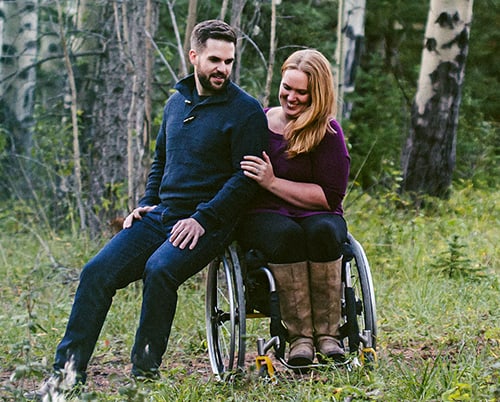
Here are two topics that often make people uncomfortable: sex and disability. Put them together, and it’s likely to make your Aunt Charlotte blush and reach for her cuppa. Add into the mix “sex toys” and she’ll likely be topping off her hot tea with a shot of whiskey. Make that a double, please.
For one young Canadian woman, however, those words all go together like macaroni and cheese — or penises and vaginas — and the combination ought to be celebrated.
“I’m a bit shocked at how little people know about disability and sex,” says Christine Selinger. A former Paralympic canoeist, Selinger teaches people with disabilities, as well as health care workers, about sex. “To me, sex is part of daily life. We should talk about this. And I’m more than happy to help people do that. I want to help make that conversation not awkward.”
When she was first injured, though, she wondered about her own sex life. “I thought no one was going to want to have sex with me,” she says. “It took a long time for me to have enough self-confidence and self-worth to pursue that. There are a lot of barriers — like people in general not seeing us as sexy. And this belief is even found among those with disabilities.”
Now Selinger, 29, is an educator for Spinal Cord Injury Ontario, based in Toronto. The organization helps people with spinal cord injuries and other physical disabilities achieve independence and self-reliance as they rebuild their lives after an accident or illness. She leads sessions on a number of subjects for people with spinal cord injuries, and much of her work is currently through online education. Lately, she’s been specializing in sex ed.
“I cover what to expect after a spinal cord injury, especially for people with brand new injuries,” says Selinger, who in 2011 earned two bachelor degrees from University of Regina, Saskatchewan, one in education and one in science. “To hear about sexual health and subjects like bladder and bowel issues from someone who’s actually gone through this — and not all in medical jargon — makes a big difference.”
Her boss, Diana McCauley, senior manager of employment services and knowledge enterprise at SCI Ontario, says Selinger is a star employee, skilled facilitator, and an “enthusiastic advocate for people with disabilities.” She praises her for developing courses and presentations. “Sex is an important part of adult life, but often people are reluctant to ask about it,” McCauley says, adding that the classes have been very well-received, with people from across the globe reaching out for more information and resources. “Christine tells it like it is, and approaches the subject with a positive attitude, offering helpful tips in a respectful way that puts people at ease.”
Adapting Sex For Your Body
Sex following spinal cord injury can be complicated and often requires adaptations. Since sexual function is enervated at the very bottom of the spinal cord, “everyone is affected somehow,” Selinger says. “It depends on the degree of your injury — complete or incomplete — and what nerves are affected.” For example, she adds, “I can feel interior sensations, just not exterior.” People with injuries at T6 and above may experience dysreflexia. Some people have orgasms, some haven’t figured out a way to get there yet.
As a counselor she often recommends sex toys to increase pleasure. “When people think sex toys, it tends to be more taboo, like only kinky people buy toys. But that’s part of what we’re trying to change in terms of talking about people with disabilities and sex. Not that there’s anything wrong about kinky. But it’s about using pillows or love bumps or things like that to help you position in a way that your body can’t hold any more.”
She says people with SCI may have minimal or hyper-sensitivity due to their injuries, so feathers or vibrators may also increase pleasure. “It’s about adapting sex, making it work for your body,” she says. “There’s nothing wrong with that.”
Her sex ed talks also include the topic of erections and condoms. Men want to know how you can keep a condom on if you can’t retain an erection. “Well,” she says, “there are female condoms. So if you’re having penetrative sex, you can insert a female condom, and you don’t have to worry about pregnancy and STDs, while also not having to worry about your erection coming and going.”
Selinger, a passionate speaker with a sense of humor and a sparkle in her eyes, says one of the first questions men new to disabilities ask is about sex, whereas most women are initially more timid on the subject. “Girls! We really need to talk about sex more,” she declares. “We need to have those conversations. Because it’s an important part of life. It’s not something you need to shy away from.” [See “Women’s Pleasure,” page 24.]
Always Persistent and Driven
Selinger was 19 in December 2006 when a rappelling accident in British Columbia resulted in her sustaining an incomplete L1 injury. For her, this means she has slight sensation and movement below her abdomen.
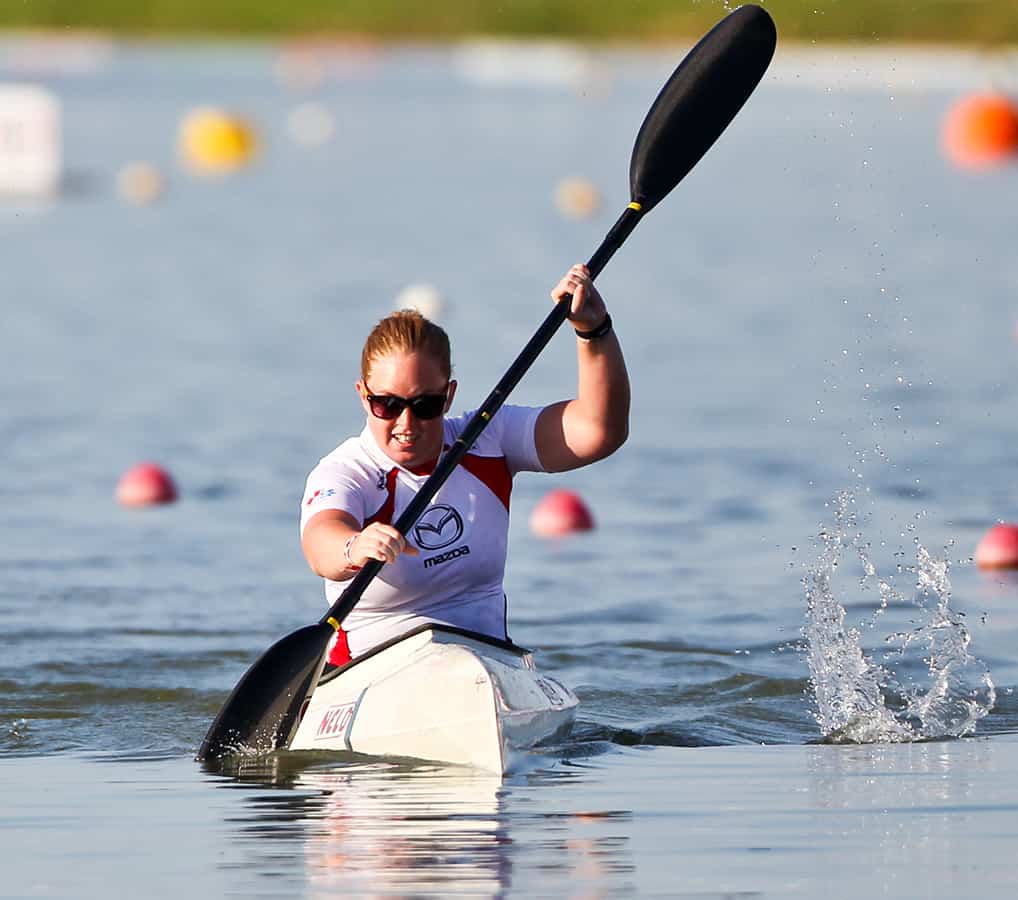
She recalls her family buoying her up after her accident, but her inborn nature was vitally important as well. “At first it’s really embarrassing because you tend to have a good number of accidents. And, remember, I was just 19,” she says, a smile in her voice. “I said to my mom, ‘I bet you didn’t think you were going to change diapers this late in the game.’”
Her sense of humor is one coping mechanism. Christine’s older sister, Chelsea, says Christine was born with other characteristics that also helped her adjust to the dramatic change in her life.
“She’s always been persistent. I’d call her a stubborn redhead,” Chelsea says, laughing. “That’s been a trait she’s had her whole life. What might have been an annoying trait as a child — to me as her older sister — has, I suppose, turned to an admirable trait. And the accident definitely didn’t stop that. Her attitude and approach to life has always been that. She’s an optimist, has a sunny outlook on everything. She’s persistent and driven, very driven, always driven.”
This persistence and drive became more apparent when, after her injury, Selinger was paired with a mentor, Clayton Gerein, a quad who nudged her toward water sports.
From Mentee to Champion
Although she did go for outdoor adventures before the accident, she wasn’t into organized sports. “I wasn’t actually an athlete before my injury at all. I didn’t like sport, anything having to do with a ball,” she says with a contagious laugh. “I was always chosen last on teams.” But under Gerein’s tutelage this quickly changed.
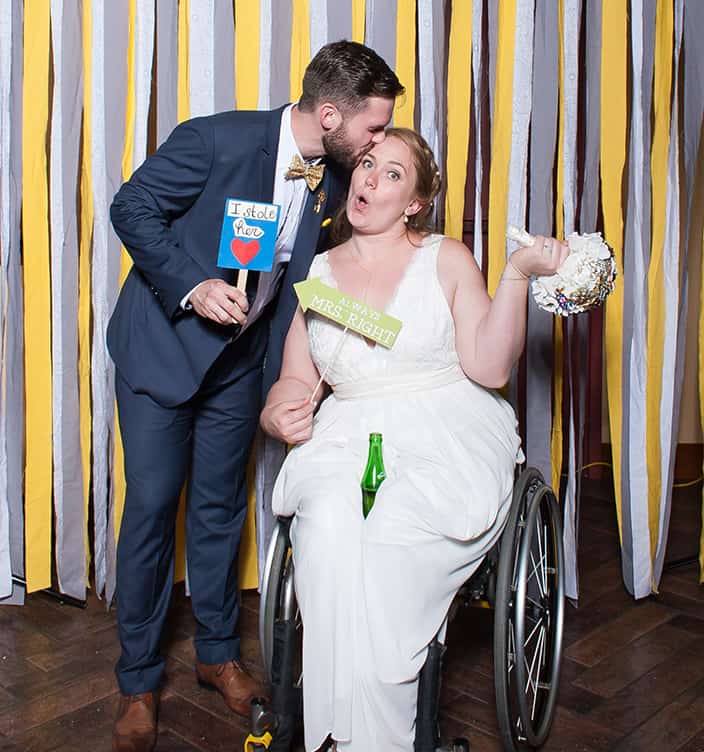
“I was introduced to him by my social worker when I started asking about travel,” she recalls. “He was wonderful. He taught me everything I knew. He was the ‘me’ of me.” Gerein, who was inducted into the Canadian Paralympic Hall of Fame in 2011 for his role as coach and mentor as well as his athleticism, died in 2010.
He guided Selinger to competitive kayaking and canoeing, where she could meet others with spinal cord injuries and learn what her post-injury body could do. She went from not being able to balance in a kayak without tumbling out into the water, to becoming a dominant competitor, winning 10 international medals, including the first-ever Women’s Paracanoe V1 World Championship in 2010.
That same year, she was the first paraplegic to go on an expedition along the Nootka Trail, a rugged backcountry 22-mile-long trail in British Columbia.
Selinger, whose paddling nickname was “Sully,” is a retired paracanoe sprint champion and mentor in her own right. Known for being a coach and adventurer as well, she has been instrumental in promoting adaptive paddling. According to the World Paddle Awards website, “her efforts undoubtedly aided getting paracanoe into the Rio 2016 Paralympic Games.”
A Turn Toward Intimacy
While still competing in paracanoe, Selinger returned to her studies at the University of Regina, Saskatchewan, where her life took a turn toward romance. That’s when she met her future husband Jerrod Smith in an algebra class.
“Jerrod was the one I figured it out with,” she says, regarding intimacy. “It helped that we were friends before we started dating. We had a lot of conversations.” Jerrod and Christine finished their undergrad studies and moved across the country to Toronto in 2011 after dating for just six months. They were married in June 2016.
Jerrod says while he appreciates that his wife’s drive enabled her to win championships, he knows sometimes people put her up on a pedestal, which is not what she wants.
“That’s something Christine deals with, the attitude that as a disabled person you are either inspirational or you’re sad. Either you’re a Paralympian or you don’t leave your basement,” says Jerrod. “Christine gets lumped into the inspirational category. She sometimes just wants to be Christine.”
Like when they’re relaxing at home. “We’re sitting together on the couch watching Netflix just like other couples are,” says Jerrod. “Once we do end up in the bedroom, Christine’s taller than me, and it’s just more an even playing field.”
With one exception, he admits.
“If I lean over and tickle her, she’s going to beat me,” he says because her upper body is stronger than his.
Jerrod encourages people to keep an open mind about relationships between nondisabled and disabled people. “You hear lots of stories about someone set up on a date with someone in a wheelchair … and they turn and run. I think that’s sad. It may be the love of your life who just sits a lot, uses a wheelchair, or has another disability. Openness is important and valuable.”
Clear communication helps from the male perspective, too, he says. “I think Christine would probably like more communication from me than there is. Being a mathematician, I can be pretty focused. It probably takes a little longer for things to sink in with me than Christine would like,” he admits. He is working on his Ph.D. in mathematics at the University of Toronto.
And it also takes time for the disabled person to feel comfortable in his or her own “new” body, especially in that critical period following onset of disability. Christine says at first she experienced a siege of “what-ifs.”
“What if the rope had been long enough? What if I had fallen in a different way, and just broken a leg?” she recalls, adding that she knew, of course, that it could have also been much worse.
“But I forcibly stopped that kind of thinking pretty quickly,” she says, looking back on her 19-year-old self. “It’s so easy to get caught up in that. It’s just … it’s not helpful. And I kept thinking, ‘I need to get rid of the things that aren’t helpful. There’s too much on my mind already. So I need to focus not on ‘what if,’ but ‘what is.’ And make the best of what I’ve got.”
Like everyone, Christine Selinger doesn’t know the specifics of her future. She may go back for a master’s or Ph.D., or she may take to paddling competitively again. But she is certain that she will continue to teach, as well as keep sex front and center in her life.
After all, sex is a natural part of living for all people — wheels or no wheels.
Christine and Jerrod: Learning What Works
“I tried online dating,” says Christine Selinger, “but it was just excessively complicated. When do you disclose you have a disability? Sometimes when I did, I’d never hear from them again. But then there were people interested in having sex with me only because I did have a disability … that was even more weird.”
So she took a couple of years to figure out her new body, and then met her future husband.
“Jerrod was my first sexual experience with someone else after my injury,” she says. But as a 19- and 20-year-old, she undertook sexual experimentation by herself to find out what felt good — and what didn’t. “What feels good and doesn’t changes, too, because of your level of feeling,” after a spinal cord injury. “Erogenous zones can completely change.
“Because we’d known each other for so long, Jerrod and I had had the awkward conversations about the bladder and bowel accidents that might happen. He prepared for it. But I don’t think either of us were really prepared for it when we started having sex.”
She says she now usually prepares by voiding before sex, but accidents can still occur. “It doesn’t often happen, but when it does happen, I still feel very embarrassed, but Jerrod makes me very comfortable with all that.”
She recalls their first time: “I didn’t know what was going to work or not going to work. I didn’t know what I’d feel or not feel. We had to get creative with it.”
Jerrod agrees: “We tried to read to each other what was working and what wasn’t working. Some things are good and some not good. After dating and living together, and now being married, we’ve figured a lot of that out.” He pauses. “You just have to practice a lot.”
They both laugh.
Christine was not dating anyone at the time of her life-changing rappelling accident.
“I wasn’t in a relationship when I sustained my injury,” she says, adding that she now knows many people who were. Those people had to figure things out in a new way in their sex life and their couplehood. “One woman I knew drew a body map, labeled what she could and could not feel. That gave them a place to start.”
“The biggest thing for me? Think of it as an adventure instead of an ordeal. We can figure this out together how to have fun, adventurous sex, instead of thinking, ‘I don’t know how to get off, and I guess I can just do what works for them.’ We’re trying to have fun and then branching out. We found what works for us,” she says. “We have a select few things in our repertoire.”
“And we know how to go back to the well if we need to,” Jerrod adds, meaning using the sexual basics in addition to new ideas and positions.
For this couple, the main sexual challenge is holding in a position. “The biggest thing is the positioning,” Christine says. “Realistically, it’s never going to be in ‘ride ‘em’ cowboy style, but we can simulate that in some ways.”
They laugh again.
“Christine on top doesn’t work so well for us. So that’s something we’re trying to do better,” Jerrod says.
“We’re always still playing with different toys and finding out what works,” she says. “I can get on top, but I can’t do any movement up there, so that kind of lacks the pizzazz. We try to find the in-between spot of rolling.”
For Christine, her inner thighs are hyper-sensitive since the accident, and not in a positive way.
“It’s not good to touch them. Jerrod had to learn that’s a no-go zone. Normally it’s an erogenous zone for someone else.“
“With Christine, it’s a good way to get a left hook,” Jerrod adds, smiling.
Support New MobilityWait! Before you wander off to other parts of the internet, please consider supporting New Mobility. For more than three decades, New Mobility has published groundbreaking content for active wheelchair users. We share practical advice from wheelchair users across the country, review life-changing technology and demand equity in healthcare, travel and all facets of life. But none of this is cheap, easy or profitable. Your support helps us give wheelchair users the resources to build a fulfilling life. |


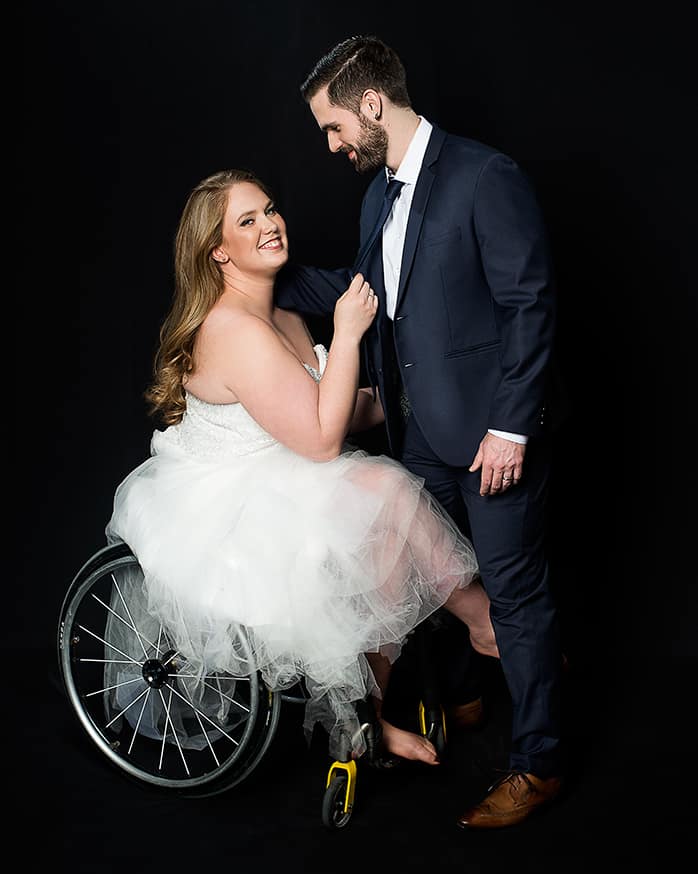
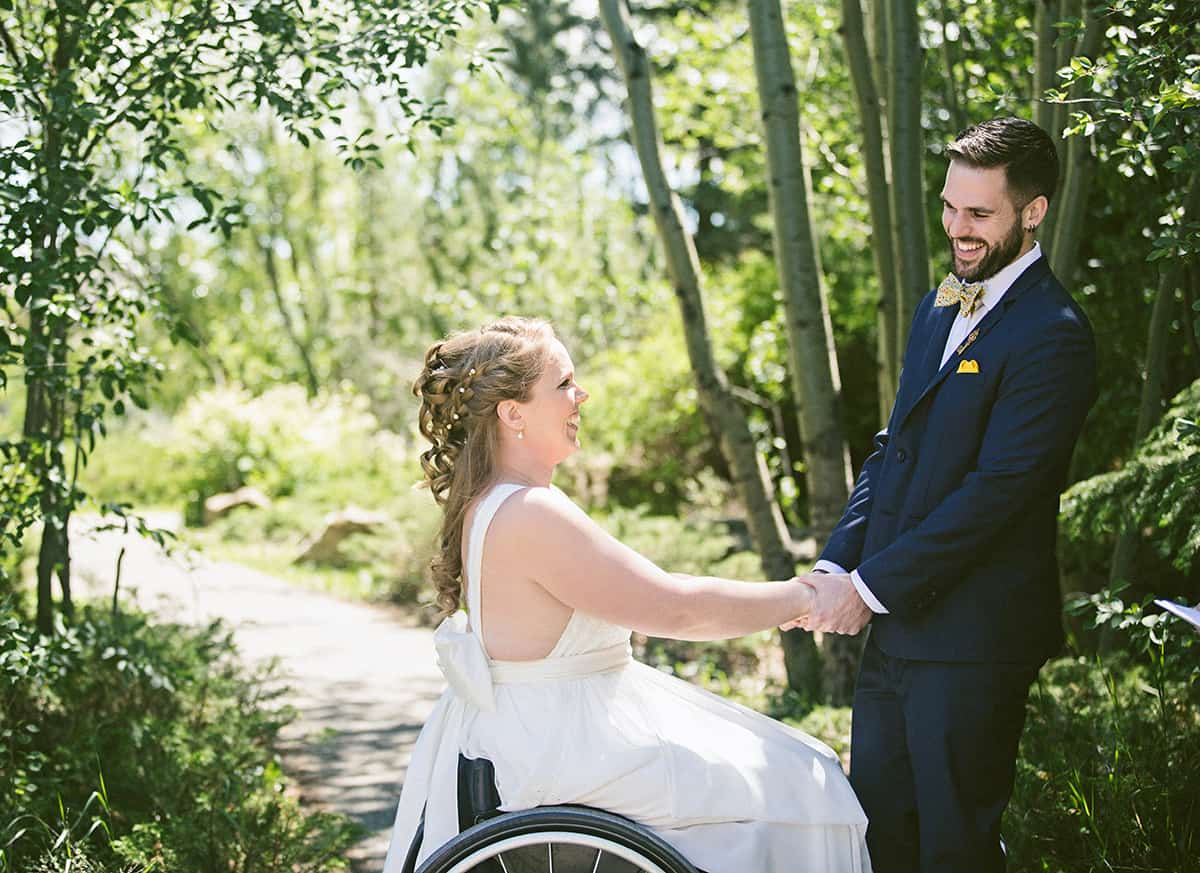
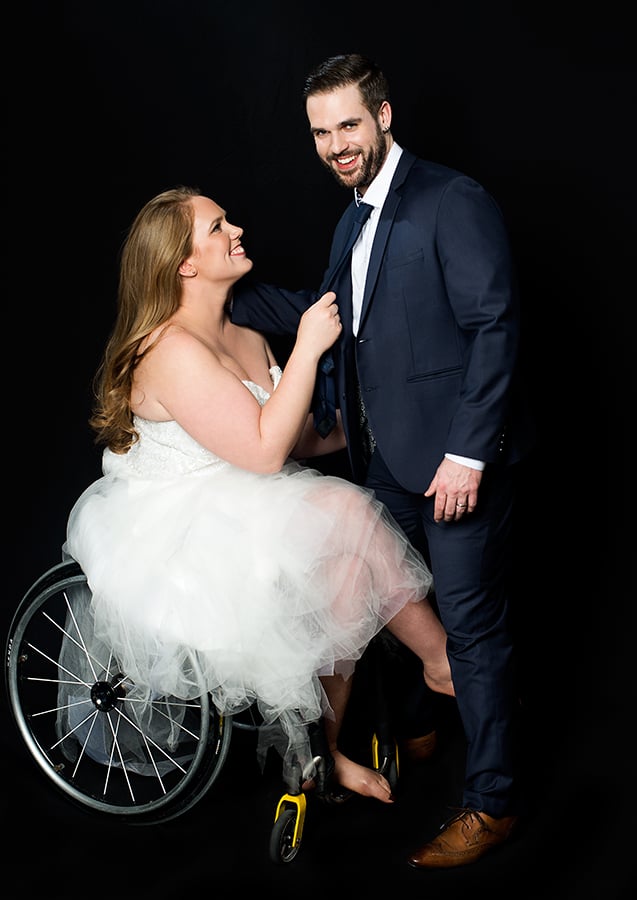

Recent Comments
Kelly DeBardelaben on Tips to Maintain Bowel Regularity with SCI When You Travel
Glen Gregos on Traveling With and Without a Caregiver
Sue on Controller Recall Puts SmartDrive Safety in the Spotlight